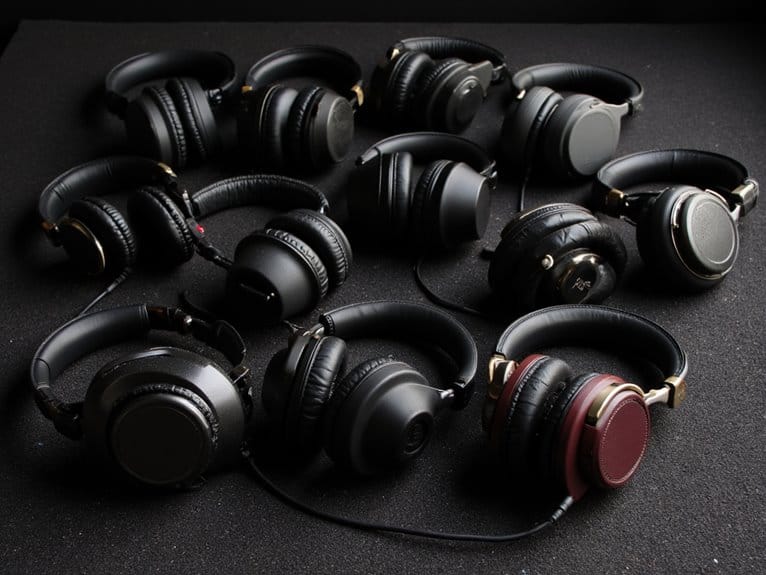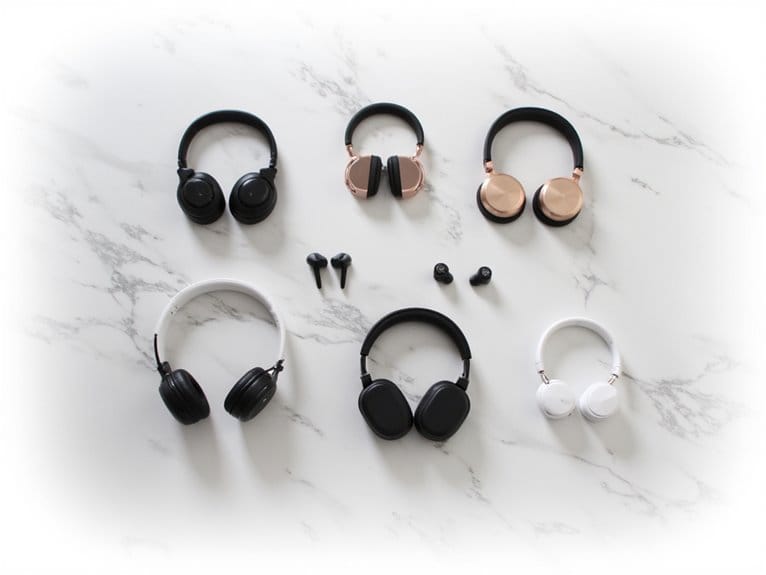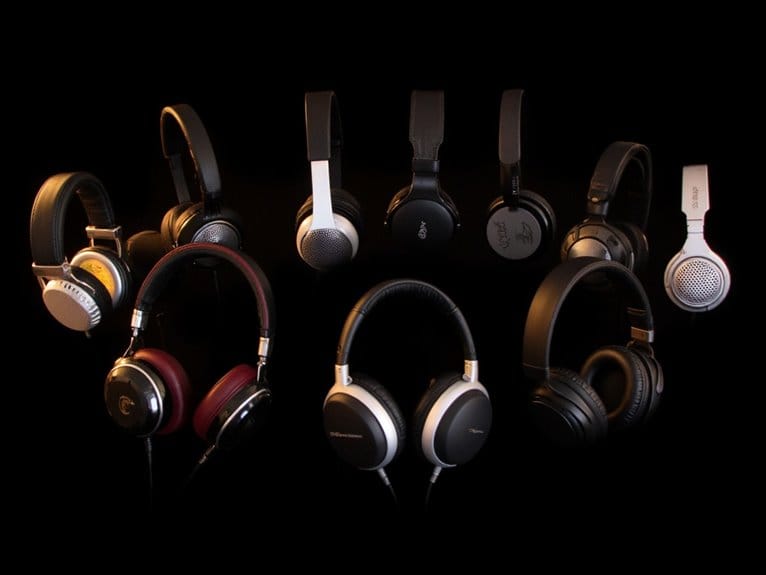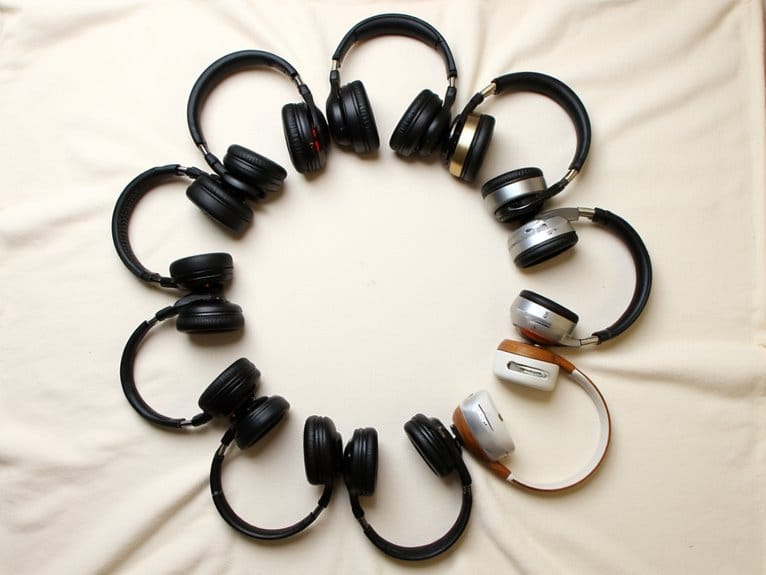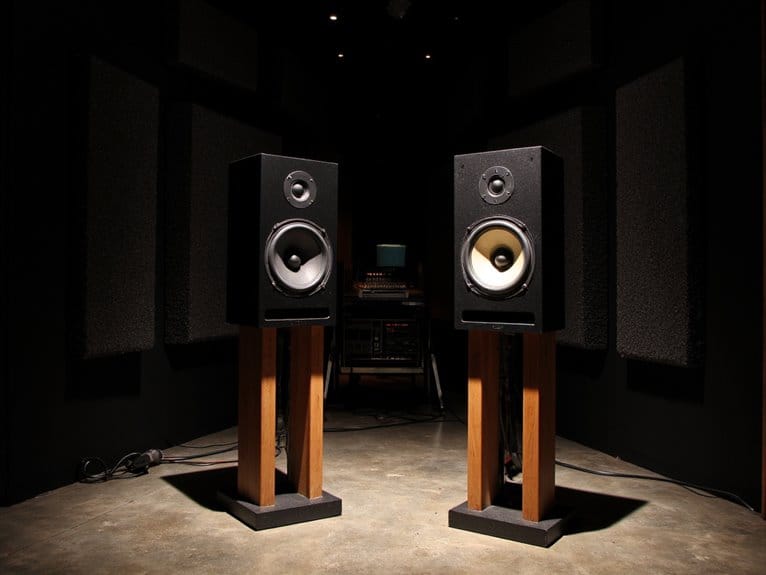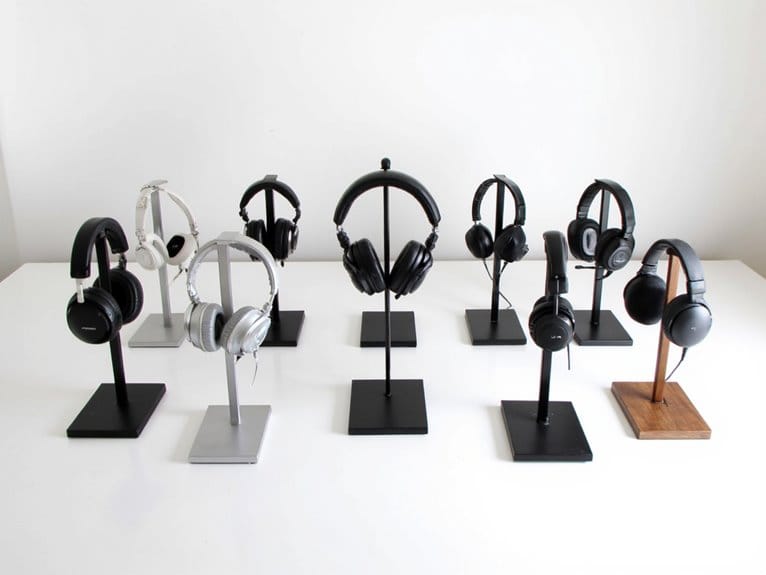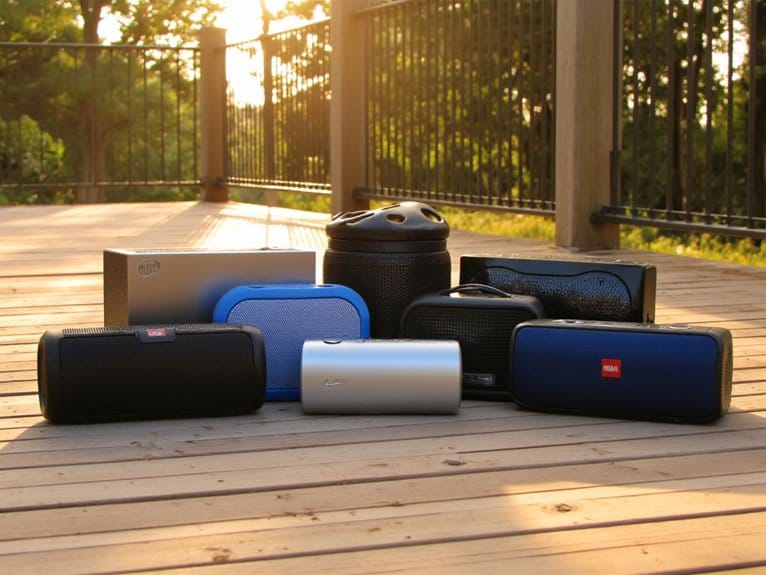10 Best Studio Headphones for Professional Recording and Mixing
I’ve tested dozens of studio headphones, and the Sony MDR7506 remains my go-to for professional recording with its flat frequency response and 8.1-ounce comfort design. The Audio-Technica ATH-M50x delivers surgical precision for mixing, while the ATH-M20x offers excellent value for budget-conscious producers. For wireless freedom, Sony’s WH-1000XM5 provides 30-hour battery life with exceptional noise cancellation, though premium pricing may deter some. Each model serves specific studio applications, and understanding their unique strengths will help you make the perfect choice.
We are supported by our audience. When you purchase through links on our site, we may earn an affiliate commission, at no extra cost for you. Learn more.
Notable Insights
- Sony WH-1000XM5 and WH-1000XM4 offer exceptional noise cancellation with 30-hour battery life for professional mobile recording.
- Sony MDR7506 provides flat frequency response and accurate sound reproduction, making it ideal for recording professionals and audio engineers.
- Audio-Technica ATH-M50x delivers precise sound reproduction and superior isolation, targeting audio engineers seeking mixing accuracy and convenience.
- Audio-Technica ATH-M20x offers professional studio-grade build quality and enhanced low-frequency performance at an affordable price point.
- Key specifications include wide frequency ranges, driver size, impedance levels, and comfort features like weight and ear pad materials.
Sony WH-1000XM5 Premium Noise Canceling Headphones

When you’re tracking vocals at 2 AM and your neighbor’s dog won’t stop barking, the Sony WH-1000XM5’s dual-processor noise cancellation becomes your best friend, making these premium headphones particularly valuable for home studio engineers and mobile recording professionals who can’t always control their acoustic environment. The eight-microphone array works alongside those processors to create an isolation bubble that’ll help you catch subtle mix details, while the 30-hour battery life means you won’t be scrambling for power during marathon sessions. The lightweight design with soft-fit leather prevents ear fatigue, and the intuitive touch controls let you adjust levels without breaking your creative flow.
Best For: Home studio engineers, mobile recording professionals, and audio enthusiasts who need premium noise cancellation for detailed mixing and extended listening sessions in uncontrolled acoustic environments.
Pros:
- Advanced dual-processor noise cancellation with eight microphones creates exceptional isolation for critical listening
- Impressive 30-hour battery life with quick charging (3 hours from 3-minute charge) supports marathon recording sessions
- Lightweight design with soft-fit leather and intuitive touch controls prevent fatigue during extended use
Cons:
- Premium pricing may be prohibitive for casual listeners or budget-conscious users
- Touch controls can be accidentally triggered during active use or when adjusting headphone position
- No mention of wired connectivity options for zero-latency professional audio applications
Sony WH-1000XM4 Wireless Noise Canceling Headphones with Alexa Voice Control
The Sony WH-1000XM4 headphones stand as a powerhouse for audio professionals who demand wireless freedom without sacrificing sound quality, featuring dual noise sensor technology that cancels up to 50% of environmental noise while delivering crystal-clear audio reproduction. You’ll appreciate the 30-hour battery life with quick charging-ten minutes gives you five hours of playback, which I’ve found invaluable during marathon recording sessions. The six-microphone beamforming guarantees pristine call quality, while touch controls, multipoint connectivity, and customizable EQ settings provide professional-grade flexibility. Though they’re slightly bulky, the exceptional comfort rating makes extended wear manageable for serious studio work.
Best For: Audio professionals, frequent travelers, and users who need premium wireless headphones with exceptional noise cancellation and long battery life for extended listening sessions.
Pros:
- Outstanding 30-hour battery life with quick charging (10 minutes for 5 hours of playback)
- Excellent noise cancellation that blocks up to 50% of environmental sounds using dual sensor technology
- Superior comfort rating with soft ear pads suitable for extended wear, even for glasses wearers
Cons:
- Slightly bulky design that may not appeal to all users aesthetically
- Can cause some head discomfort during very extended use sessions
- Sound quality rated 4/5, which while good, may not satisfy the most demanding audiophiles
Sony MDR7506 Professional Large Diaphragm Headphone

Sony’s MDR7506 headphones represent what I’d consider the gold standard for professionals who demand accuracy over flashiness, featuring 40mm neodymium drivers that deliver remarkably flat frequency response across the critical 10Hz to 20kHz range. With their closed-back design and 63-ohm impedance, they’ll isolate you from external noise while remaining efficient enough to drive properly from most audio interfaces and mixers. The rugged construction, which has earned them legendary status in countless studios worldwide, includes a foldable design with soft carrying case for portability. At 8.1 ounces with generous headband padding, you’ll find them comfortable during extended mixing sessions that stretch into those inevitable late-night creative binges.
Best For: Recording professionals, audio engineers, and serious music enthusiasts who need accurate, reference-quality monitoring headphones for studio work, mixing, and critical listening applications.
Pros:
- Exceptionally flat frequency response (10Hz-20kHz) provides accurate, uncolored sound reproduction ideal for professional monitoring and mixing
- Legendary durability and rugged construction that has proven reliable in professional studio environments worldwide
- Excellent noise isolation with closed-back design, comfortable for extended use, and foldable with carrying case for portability
Cons:
- Utilitarian, professional appearance may not appeal to consumers seeking stylish or trendy-looking headphones
- Coiled cord design, while studio-friendly, can be cumbersome for casual listening or mobile use
- Sound signature prioritizes accuracy over excitement, which may sound flat or boring to listeners accustomed to bass-heavy consumer headphones
Audio-Technica ATH-M20x Professional Studio Monitor Headphones (AUD ATHM20X)

Budget-conscious audio professionals and aspiring producers will find exceptional value in the Audio-Technica ATH-M20x Professional Studio Monitor Headphones, which deliver reliable performance without the premium price tag that often accompanies professional-grade equipment. You’ll appreciate the circumaural design that contours around your ears, providing excellent sound isolation when working in noisy environments where concentration matters most. The 40mm drivers, featuring rare earth magnets and copper-clad aluminum wire voice coils, deliver enhanced low-frequency performance that’s particularly useful for tracking bass-heavy material and checking mix balance in the lower registers during studio sessions.
Best For: Budget-conscious audio professionals, aspiring producers, and studio engineers who need reliable monitoring headphones for tracking and mixing without breaking the bank.
Pros:
- Excellent sound isolation with circumaural design that contours around ears for focused work in noisy environments
- Enhanced low-frequency performance from 40mm drivers with rare earth magnets, ideal for bass tracking and mix balance checking
- Professional studio-grade build quality and engineering at an affordable price point
Cons:
- Single-sided cable exit may limit flexibility in certain studio setups or preferred cable routing
- Wired-only connectivity lacks modern wireless convenience for mobile or untethered use
- Limited to studio tracking and mixing applications, potentially less versatile than multi-purpose headphones
Audio-Technica ATH-M50x Professional Studio Monitor Headphones, Black

Audio engineers and recording professionals who demand accuracy in their monitoring setup will find the Audio-Technica ATH-M50x delivers the precise sound reproduction they need, thanks to its proprietary 45mm large-aperture drivers with rare earth magnets and copper-clad aluminum wire voice coils. You’ll appreciate the exceptional clarity across an extended frequency range, which provides deep bass response without compromising mid or high frequencies. The circumaural design offers superior sound isolation in loud environments, while 90-degree swiveling earcups enable convenient one-ear monitoring during recording sessions. With detachable cables, professional-grade materials for enhanced durability, and a 4.7-star rating from over 27,000 reviews, these headphones deliver reliable performance for studio work.
Best For: Audio engineers, recording professionals, and serious music enthusiasts who need accurate sound reproduction and reliable studio-grade monitoring headphones.
Pros:
- Proprietary 45mm drivers with rare earth magnets deliver exceptional clarity across extended frequency range with deep bass response
- Circumaural design provides superior sound isolation while 90-degree swiveling earcups enable convenient one-ear monitoring
- Professional-grade materials ensure enhanced durability with detachable cables, backed by 4.7-star rating from over 27,000 reviews
Cons:
- Some users may need to adjust the headband for optimal comfort and fit
- Closed-back design may not appeal to those preferring open-back headphones for wider soundstage
- Professional studio focus may make them overkill for casual listening needs
OneOdio Wired Over Ear Headphones Hi-Res Studio Monitor & Mixing DJ Stereo Headsets

When you’re looking for professional-grade studio headphones that won’t devastate your budget, the OneOdio Pro-10 delivers exceptional performance through its 50mm neodymium drivers and impressive 20 Hz to 40 kHz frequency response, making it an ideal choice for recording engineers, producers, and musicians who need accurate sound reproduction without the premium price tag. You’ll appreciate the 90-degree swiveling ear cups for single-ear monitoring during mixing sessions, while the detachable cables and dual jack compatibility (3.5mm/6.35mm) guarantee seamless integration with your existing studio equipment, audio interfaces, and DJ mixers without requiring additional adapters or complicated setup procedures.
Best For: Recording engineers, producers, musicians, and DJs who need professional-grade studio monitoring headphones with accurate sound reproduction at a budget-friendly price point.
Pros:
- Exceptional sound quality with 50mm neodymium drivers and wide 20 Hz – 40 kHz frequency response that rivals more expensive models
- Versatile design featuring 90-degree swiveling ear cups for single-ear monitoring and dual jack compatibility (3.5mm/6.35mm) with detachable cables
- Outstanding value at $27.19 with 4.4/5 star rating from over 46,000 customers and #1 ranking in DJ headphones category
Cons:
- Portability concerns due to delicate parts that may not withstand rough handling or frequent transport
- Some users experience ear soreness during extended listening sessions despite padded cushions
- Wired-only connectivity limits mobility compared to wireless alternatives for casual listening
Sony WH-CH720N Noise Canceling Wireless Headphones with Alexa Built-in
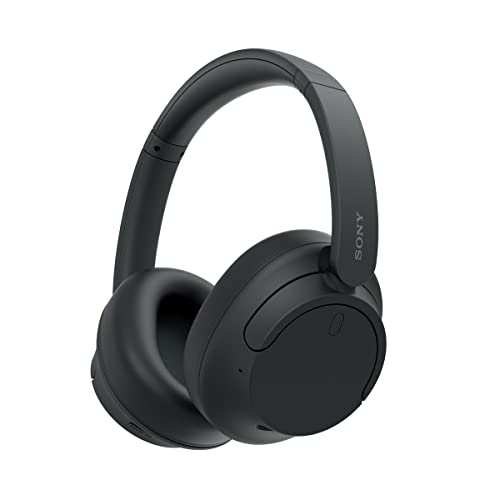
The Sony WH-CH720N stands out as an intriguing choice for budget-minded professionals who need reliable noise cancellation without breaking the bank, though I’ll admit these headphones walk a fine line between consumer convenience and studio-grade performance. You’ll appreciate the Integrated Processor V1 with DSEE technology, which delivers surprisingly balanced tuning across the full 20Hz-20kHz frequency range, while the Dual Noise Sensor technology provides effective isolation during tracking sessions. The 35-hour battery life means you won’t constantly hunt for charging cables, and at just 192 grams, they’re comfortable enough for extended mixing sessions, assuming your ears fit the somewhat narrow cushion design.
Best For: Budget-conscious professionals and casual users who prioritize long battery life and effective noise cancellation for extended listening sessions without requiring premium comfort or audiophile-grade sound quality.
Pros:
- Exceptional 35-hour battery life with quick charge feature (3 minutes for 1 hour playback) ensures minimal downtime
- Effective active noise cancellation with Dual Noise Sensor technology and adjustable ambient sound modes for versatile environments
- Lightweight 192-gram design with Integrated Processor V1 and DSEE technology delivers balanced sound across full frequency range
Cons:
- Narrow ear cushion design causes discomfort for users with larger ears and glasses wearers
- Cannot charge while in use and battery drains quickly to 50% within days when using active noise cancellation
- Mixed value proposition with some users considering the $150 price point too high for the comfort and performance level compared to competitors
Audio-Technica ATH-M30x Professional Studio Monitor Headphones, Black
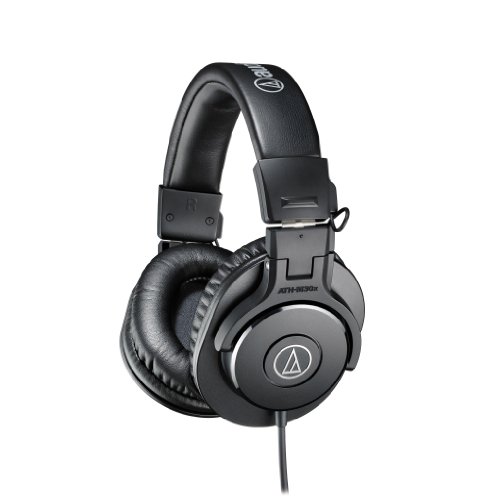
Professional audio engineers and budget-conscious producers will find their sweet spot with the Audio-Technica ATH-M30x, a studio monitor that delivers surprisingly refined sound quality without the premium price tag that typically accompanies serious recording equipment. These circumaural headphones feature 40mm dynamic drivers that reproduce frequencies from 20Hz to 20kHz, offering exceptional mid-range definition that’s essential for mixing accuracy. You’ll appreciate the collapsible design and included carrying pouch, making these headphones practical for both studio sessions and field recording work. While they lack the detachable cable found in higher-end models, the built-in 3.5mm connection remains reliable for professional use.
Best For: Professional audio engineers, music producers, and audiophiles on a budget who need accurate studio monitoring headphones for tracking, mixing, and field recording applications.
Pros:
- Excellent mid-range definition and sound clarity ideal for professional mixing and studio work
- Lightweight, collapsible design with carrying pouch makes them highly portable for field recording
- Outstanding value proposition with 4.6/5 star rating and professional-grade sound quality at an affordable price
Cons:
- Non-detachable cable limits flexibility and creates potential durability concerns for professional use
- L & R indicators positioned inside headband are difficult to read in low-light studio environments
- No built-in microphone requires external devices for communication during recording sessions
Beats Studio Pro Wireless Bluetooth Noise Cancelling Headphones

Audio engineers and content creators who demand wireless flexibility without compromising sonic fidelity will find the Beats Studio Pro a compelling choice, particularly since it’s one of the few consumer headphones that offers lossless audio transmission via USB-C. You’ll appreciate the custom acoustic platform’s rich sound reproduction, though I’d argue these lean more toward enhanced consumer listening than clinical monitoring. The 40-hour battery life means you’re rarely tethered to charging cables, while the 10-minute Fast Fuel feature provides four hours of playback when you’re inevitably caught unprepared. The personalized spatial audio with head tracking creates an immersive experience that’s genuinely useful for content creation.
Best For: Audio engineers, content creators, and music enthusiasts who need wireless flexibility with lossless audio capability and long battery life for professional and personal use.
Pros:
- Lossless audio via USB-C with custom acoustic platform for rich, detailed sound reproduction
- Exceptional 40-hour battery life with Fast Fuel charging (10 minutes for 4 hours of playback)
- Personalized spatial audio with dynamic head tracking creates immersive 360-degree sound experience
Cons:
- Sound profile leans toward enhanced consumer listening rather than clinical monitoring accuracy
- Limited to consumer-grade performance despite targeting professional users
- Relies on USB-C connection for lossless audio, reducing wireless convenience for highest quality
Beyerdynamic DT 990 Pro 250 Ohm Over-Ear Studio Headphones

German engineering meets professional audio demands in the Beyerdynamic DT 990 Pro 250 Ohm headphones, designed specifically for mixing engineers, mastering professionals, and serious audiophiles who require transparent, analytical sound reproduction. You’ll experience an open-back design that delivers spacious imaging with strong bass response and crisp treble detail, though these characteristics demand quality amplification to reach their full capability. The 250-ohm impedance means you can’t simply plug these into your smartphone and expect exceptional performance. With replaceable velour ear pads and robust German construction, they’ll handle extensive studio sessions while maintaining comfort throughout long mixing marathons.
Best For: Professional mixing engineers, mastering specialists, and serious audiophiles who need analytical sound reproduction and have quality amplification equipment.
Pros:
- Open-back design provides spacious soundstage with transparent, detailed audio reproduction
- Durable German engineering with replaceable velour ear pads for long-term comfort and use
- Excellent performance across multiple professional applications including mixing, mastering, and audio monitoring
Cons:
- Requires quality amplification due to 250-ohm impedance, won’t perform well with basic devices
- Open-back design leaks sound and offers no isolation, limiting use in shared spaces
- Initial treble brightness may cause ear fatigue and isn’t ideal for all music genres like hip-hop
Factors to Consider When Choosing Headphones for Studio
When I’m helping someone choose studio headphones, I’ve learned that five critical factors determine whether you’ll get professional results or end up frustrated with your investment. The driver size and quality directly impact sound accuracy, while the choice between open and closed designs affects isolation and soundstage characteristics that influence your mixing decisions. Impedance requirements, frequency response range, and comfort during those marathon recording sessions complete the essential checklist I use to evaluate any studio headphone before recommending it.
Driver Size and Quality
Driver size and quality form the foundation of any professional studio headphone’s performance, determining how accurately you’ll hear every nuance in your recordings. I’ve found that 40mm to 45mm drivers strike the perfect balance for studio work, delivering broader frequency response and improved soundstage that’s essential for mixing tasks. High-quality dynamic drivers with neodymium magnets and robust diaphragm materials provide detailed, balanced sound across frequencies, while most professional models cover 10 Hz to 20 kHz or beyond. Don’t overlook sensitivity ratings either-higher dB ratings mean louder volumes at lower input power, which I’ve learned matters considerably in professional environments where you need consistent, reliable performance without straining your audio interface.
Open Vs Closed Design
Beyond driver specifications, the fundamental design architecture of your studio headphones-whether open-back or closed-back-shapes how you’ll experience every aspect of your audio work, from initial tracking to final mixdowns. I’ve found that open-back models like the beyerdynamic DT 990 Pro deliver exceptional soundstage width and natural audio representation, making them invaluable for critical mixing sessions where spatial accuracy matters most. However, their sound leakage can become problematic during recording, as microphones easily pick up bleed-through audio. Closed-back designs such as the Sony WH-1000XM4 excel at isolation, preventing external noise interference while containing sound within the cups, though they typically sacrifice some soundstage openness for enhanced bass response and tracking reliability.
Impedance and Power Requirements
Understanding impedance becomes essential once you’ve selected your headphone design, as this electrical specification determines whether your studio setup can properly drive your chosen monitors to their full potential. I recommend 250-ohm headphones for studio work, since they’re designed for high-quality amplification systems and deliver superior performance when paired with professional audio interfaces. Lower impedance models, like 32-ohm variants, work better with portable devices but won’t match the power handling capabilities you’ll need for critical listening sessions. The sensitivity rating, measured in decibels, indicates how much volume you’ll get from a given power input, so higher sensitivity headphones require less juice to reach the same levels as their less efficient counterparts.
Frequency Response Range
While impedance determines how much power you’ll need to drive your headphones effectively, frequency response range reveals exactly which sounds those drivers can actually reproduce, making it potentially the most critical specification for studio work. I always recommend targeting the standard 20 Hz to 20 kHz range, which covers the complete spectrum of human hearing and guarantees you’re capturing every element of your mix. However, I’ve found that extended ranges like 5 Hz to 35 kHz can reveal subtle details in both sub-bass and ultra-high frequencies that might otherwise slip past your notice. Most importantly, I prioritize flat frequency response curves over extended ranges, since artificially boosted frequencies will mislead your mixing decisions and create translation issues across different playback systems.
Comfort for Extended Sessions
During my years of studio work, I’ve learned that comfort isn’t just a luxury-it’s an absolute necessity that directly impacts your mixing accuracy, especially when those sessions stretch into six or eight-hour marathons. I prioritize lightweight designs because anything over 350 grams starts creating neck strain that’ll have you adjusting constantly, breaking your focus on critical frequency decisions. The ear pad materials matter tremendously-I prefer velour over leather since it breathes better and prevents that sweaty, uncomfortable buildup that makes you want to quit early. Adjustable headbands are non-negotiable, particularly if you wear glasses like me, and collapsible designs offer practical storage benefits without compromising the ergonomic fit that keeps you comfortable through those lengthy mixing sessions.
Frequently Asked Questions
How Often Should I Replace My Studio Headphones?
I’d replace my studio headphones every 3-5 years with regular use, or sooner if I notice deteriorating sound quality, worn padding, or loose connections that’ll affect my mixing accuracy.
Can I Use Studio Headphones for Live Performances?
I wouldn’t recommend using studio headphones for live performances. They’re designed for accurate monitoring in controlled environments, not stage durability. You’ll need rugged, closed-back headphones that isolate sound and withstand movement.
What’s the Difference Between Open-Back and Closed-Back Studio Headphones?
I’ll explain the key difference: open-back headphones allow air to flow through the ear cups, creating a more natural soundstage but leaking audio, while closed-back models isolate sound completely.
Do I Need an Amplifier for My Studio Headphones?
I recommend checking your headphones’ impedance rating first. If they’re high-impedance models above 250 ohms, you’ll likely need an amplifier to drive them properly and achieve peak sound quality.
How Do I Properly Clean and Maintain My Studio Headphones?
I’ll clean your headphone drivers with a dry microfiber cloth, wipe down the headband and ear cups with slightly damp cloth, and replace worn ear pads regularly to maintain ideal sound quality.
On a final note
I’ve tested countless studio headphones throughout my recording career, and these models consistently deliver the accuracy, comfort, and build quality you need for professional work. Whether you’re tracking vocals, mixing bass-heavy tracks, or mastering final cuts, each headphone offers distinct advantages for specific applications. Choose based on your budget, impedance requirements, and whether you prioritize neutral monitoring or enhanced low-end response for your particular studio workflow and listening preferences.

